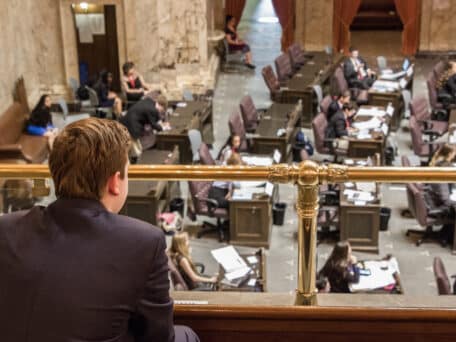Using the phrase Jay Inslee seemed so attached to during the 2012 gubernatorial campaign, the Legislature must “focus like a laser beam” on education this year. Circumstances, particularly the state Supreme Court’s decision last September to hold the Legislature in contempt due to Democrats’ failure to meet the constitutional mandate to fully fund public schools for the past 30 years, demand that this particular laser beam has some strength and direction—certainly, the laser beam Inslee employs can claim neither attribute.
In order to meet the state Supreme Court’s McCleary ruling, the state must “pump $4 billion to $5 billion more into education in the next four years, according to most estimates.” The Seattle Times points out that the Legislature must approach the problem not just by increase funding, but also by “ensuring that money produces better results for students.”
Unfortunately, Democrats are not off to a great start in the mission to actually improve education, rather than merely throw more money at the system (and their big donors in the state teachers union). The problem is Initiative 1351, which runs counter to the “standard of putting increased state education money to its best use.” As Shift extensively reported, the Washington Education Association (WEA) pushed I-1351 under the guise of smaller class sizes. In reality, the initiative was merely the WEA’s latest money grab.
The Times reminds readers “research shows positive effects from smaller class sizes happen mostly in the early grades.” Additionally, legislators “already plan to reduce class sizes in kindergarten through third grade, under the McCleary ruling.” I-1351 promises to be a thorn in the side of lawmakers already facing difficult budget negotiations—a thorn that Inslee refused to address prior to the election and in his budget proposal.
During his budget roll out, Inslee announced that he does not support repealing I-1351. Our green governor’s announcement came as no surprise—throughout his time in office, Inslee has stood faithfully by the WEA as repayment for the union’s million-dollar campaign donation.
He insisted that he is “focusing first on the K-through-3 area where [reducing class sizes] has the most success as far as bang for your buck.” Yet, while research shows that reducing class sizes works best for younger students, Inslee’s strategy simply would not achieve actual improvements to education. As Shift reported, research also makes a compelling argument that the goal of reducing class sizes is not the primary answer to improving education.
A Stanford study concluded that taxpayer dollars are best spent retaining and recruiting teachers with proven effectiveness in the classroom. The study found that a “good teacher provides about a year and a half of learning to students, while ineffective teachers provide only half a year of learning over the same time period.”
Prioritizing education is not just throwing more money at problems or reducing class sizes, it’s about improving quality. Unfortunately, Inslee and other Democrats continue to back the WEA at all costs. And, as the WEA has proven, it will stubbornly follow the practice of seniority (last one in, first one out) at all costs—even at the cost of quality teachers. As SHIFT recently reported, a talented teacher at Seattle’s Garfield High School is being threatened with dismissal due to the union’s preferred system.
Public education has to be the top priority of the 2015 Legislature. Here’s hoping lawmakers will “focus like a laser beam” on building practices that sustain quality education, not merely throw billions at a broken system.




